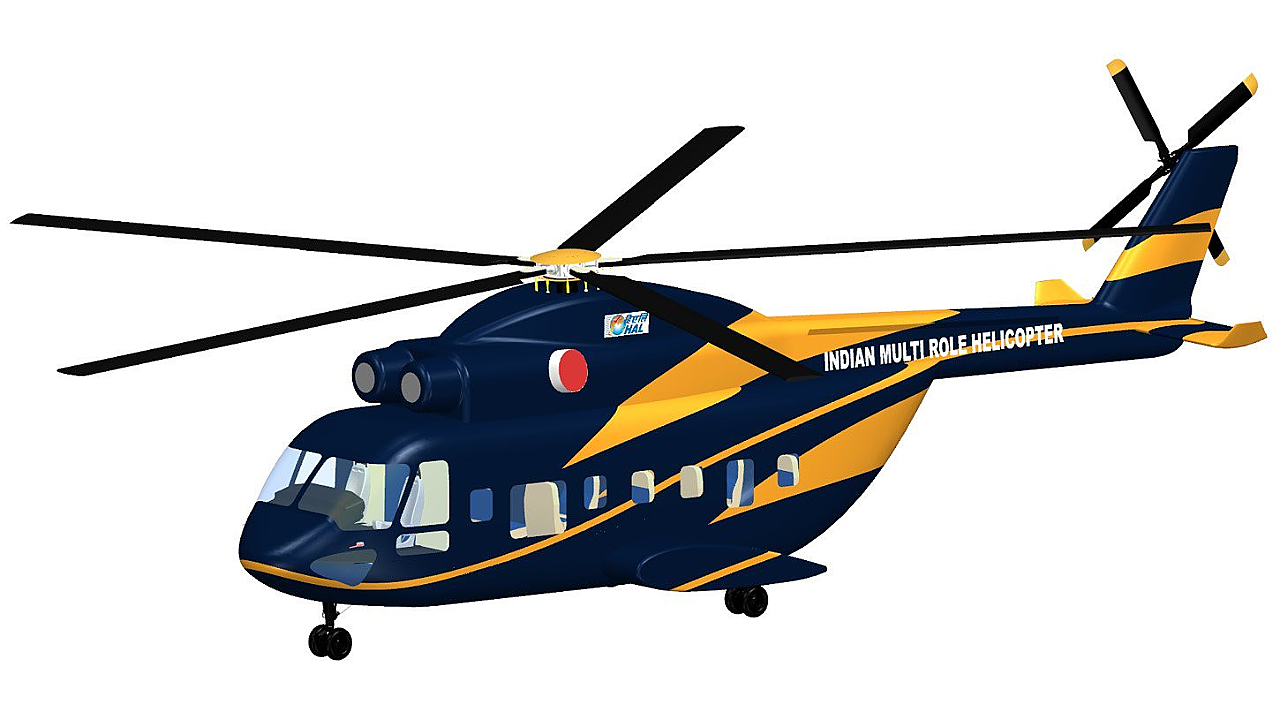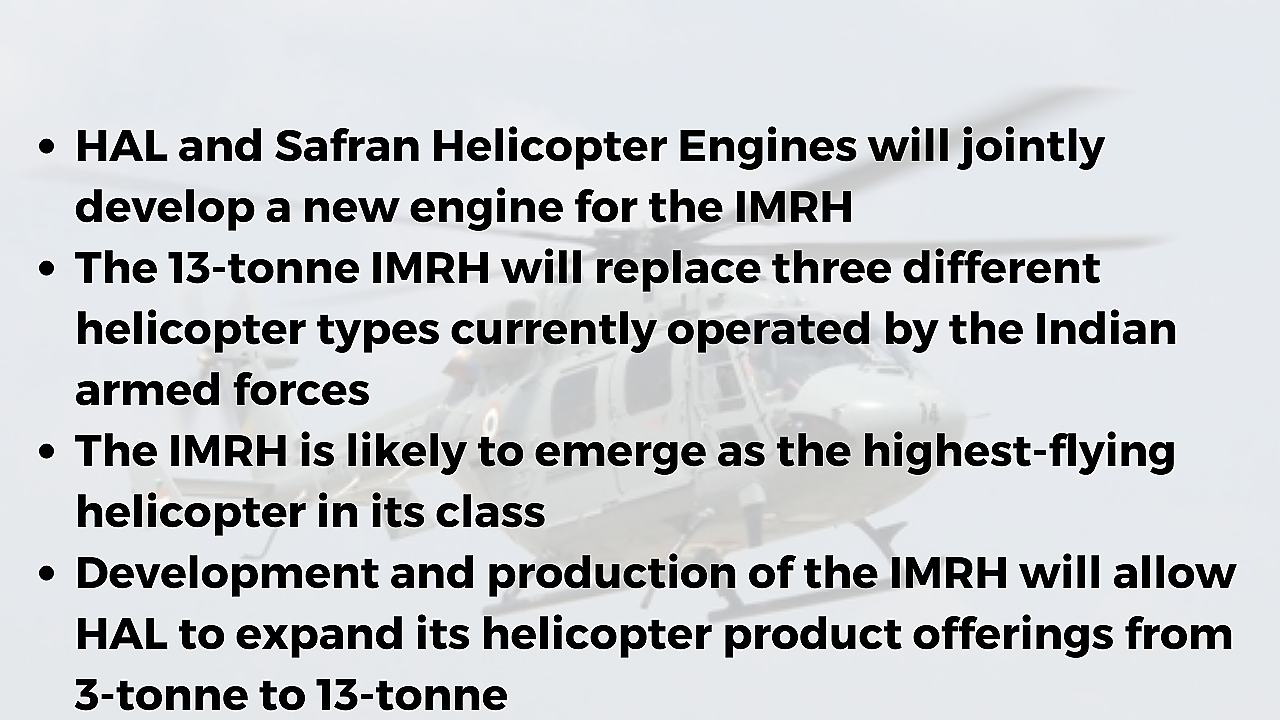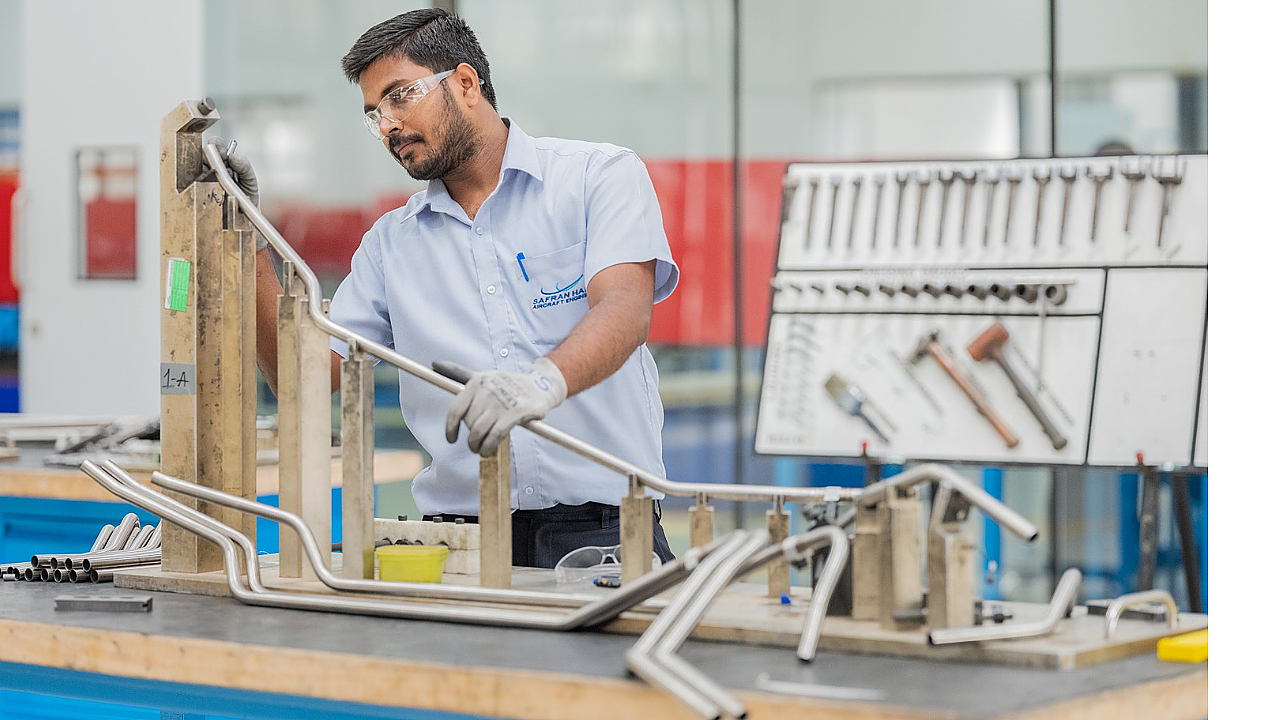
The Indian Multi-Role Helicopter (IMRH) is an important new helicopter type being developed by Hindustan Aeronautics Limited (HAL) to meet the future requirements of the Indian armed forces. The 13-tonne IMRH will be the largest helicopter designed and developed in India and is more than twice the weight of the 5.5-tonne indigenously developed Dhruv Advanced Light Helicopter (ALH). HAL anticipates the business volume related to IMRH production and Maintenance Repair & Overhaul (MRO) phases to be to the tune of over INR 160,000 crore.
The IMRH programme has now received a boost, with the HAL and Safran Helicopter Engines recently announcing an agreement to create a joint venture dedicated to helicopter engine development, production, sales and support. The JV will look to develop an engine for the IMRH, continuing Safran’s success in powering indigenous Indian helicopters in the ALH, Light Combat Helicopter (LCH) and Light Utility Helicopter (LUH). The creation of the new joint venture marked a turning point in Safran Helicopter Engines’ relationship with HAL and the Indian MoD with the development and production of a new generation helicopter engine, said Franck Saudo, Safran Helicopter Engines CEO.
Calling Safran Helicopter Engines, a valued partner of HAL for several decades, R Madhavan, CMD, HAL, said the company was looking forward to utilising this opportunity to leverage HAL’s experience in manufacturing more than 15 types of aircraft and helicopter engines to jointly co-develop and manufacture engine with an immediate focus on IMRH and its naval variant the Deck Based Multi-Role Helicopter (DBMRH). “This partnership will involve and utilise the Indian defence manufacturing ecosystem within India,” he said.
The French firm’s partnership with HAL began more than 50 years ago, and India’s armed forces are one of the largest operators of Safran-designed helicopter engines, with a fleet of over 1,000 engines. Safran and HAL also co-developed the Shakti engine, which powers Dhruv MkIII and MkIV variants and the LCH. More than 500 Shakti engines have already been produced in Bengaluru. Safran Helicopter Engines’ Ardiden 1U variant also powers the new LUH, a single-engine helicopter, unlike the Dhruv and LCH, which are twin-engine helicopters. Safran Helicopter Engines and HAL will also provide MRO services for existing TM333 (which power older Dhruv MkI and MkII helicopters) and Shakti engines in Indian service through the new HE-MRO joint venture in Goa, which is slated to be operational by the end of 2023.

Future Helicopter
The IMRH is being developed at HAL’s Rotary Wing R&D Centre (RWRDC) in Bengaluru, one of the oldest helicopter design and production agencies in Asia (if not the oldest). It was established in 1970 as Helicopter Design Bureau and later renamed RWR&DC in 1998. The IMRH was originally conceived as a 10-tonne Class helicopter to meet the Indian army, air force and navy requirements. It has now grown into a 13-tonne Class helicopter that will be able to undertake various roles for the armed forces such as support air assault, air transport, VIP transport, combat logistics viz. troop transport, combat search & rescue and casualty evacuation operations, etc.
The IMRH will have a service ceiling of 6.5 km, which is unlikely to be matched by any other helicopter in the 13-tonne weight class in the world. HAL quotes a flight endurance of three hours and a maximum cruise speed of 270 kmph. The new helicopter will have a payload of four tonne and crash-worthy tricycle landing gear. The IMRH will be equipped with an indigenously designed smart cockpit, state-of-the-art mission systems, advanced avionic systems and a 4-axis automatic flight control system. HAL RWRDC has now gained extensive experience using composites on the Dhruv, LCH and LUH helicopters, and as a result, the IMRH will feature a composite and modular airframe. The modular airframe will allow HAL to outsource production-related activities for the IMRH.
The IMRH is being developed as an indigenous replacement for existing helicopters such as the Mil Mi-17 in the air force, which were imported from Russia and the Kamov and Seaking helicopters in the navy, which were imported from Russia and the UK, respectively. Depending on its configuration, the IMRH can carry either 24 or 36 troops. The air force’s Mi-17 helicopters are slated for replacement starting from 2028 as per current plans. HAL is benchmarking the proposed IMRH against its contemporary helicopters, viz. Mi-17, S-92, AW-101, NH-90 & EC-725. Development and production of the IMRH will allow HAL to expand its helicopter product offerings across the 3-tonne to 13-tonne weight class. HAL targets an indigenous content level of a minimum of 50% for the IMRH.
Safran Bullish on India
In addition to its agreement to jointly develop a helicopter engine with HAL, Safran recently inaugurated three new production sites in India and announced the construction of a major new facility in 2025. Olivier Andriès, Chief Executive Officer, Safran, said the company was accelerating its investments and industrial development in India to support the country’s dynamic aviation market, with passenger traffic increasing in the next twenty years. “With our three new production facilities and our major in-house IT centre, we will triple the number of employees in India over the next four years, building on the excellent local talent base,” he said. Andriès also announced the creation of Digit during his visit to India. Digit will be an in-house entity tasked with developing digital systems for Safran and will have two main facilities, Hyderabad and Mumbai. Operations are slated to begin this year.
Safran’s new aerospace projects in Hyderabad will feature investments totalling over INR 1,600 crore over the next few years. Two new neighbouring plants were inaugurated on July 7 in Hyderabad for Safran Aircraft Engines and Safran Electrical & Power. The new Safran Aircraft Engines plant will span over 15,000 square meters and make rotating parts for CFM International (a 50/50 JV between Safran Aircraft Engines and GE)LEAP engines. It will provide the additional capacity the French firm needs to meet to cater for a production ramp-up for its generation's best-selling commercial airplane engine. Safran Electrical & Power’s plant makes wiring for LEAP engines and the Rafale fighter and is located in the same airport zone as the Safran Aircraft Engines plant. It started operations in November 2018 and has 150 employees today.

The MRO facility for CFM LEAP engines will be set up at the GMR Industrial Park and is slated to commence operations in 2025. The new facility will also be the largest CFM LEAP engine MRO facility in Safran’s global MRO network and will eventually offer an annual capacity of 250 to 300 engine shop visits. “Our new MRO 4.0 centre in Hyderabad will strengthen our global network and enable us to meet the needs of our CFM customers against a backdrop of booming air traffic in India and the region,” Jean-Paul Alary, Chief Executive Officer of Safran Aircraft Engines, said during the inauguration. It is expected to generate employment for approximately 2,400 people. More than 1,500 LEAP engines are currently on order in the region. The LEAP and its predecessor, the CFM56, power over 330 Airbus A320/A320neo and Boeing 737/737 MAX airplanes presently operated by Indian carriers.
Safran HAL Aircraft Engines, a 50/50 joint venture between Safran Aircraft Engines and HAL, was inaugurated in Bengaluru on July 8 and replaced an initial plant that dates back to 2005. Spanning 11,000 square meters, the state-of-the-art installation is more than double the surface area of the previous facility and makes complex piping, mostly for the LEAP engine and has approximately 150 employees. It is located in a Special Economic Zone near the Bangalore airport.